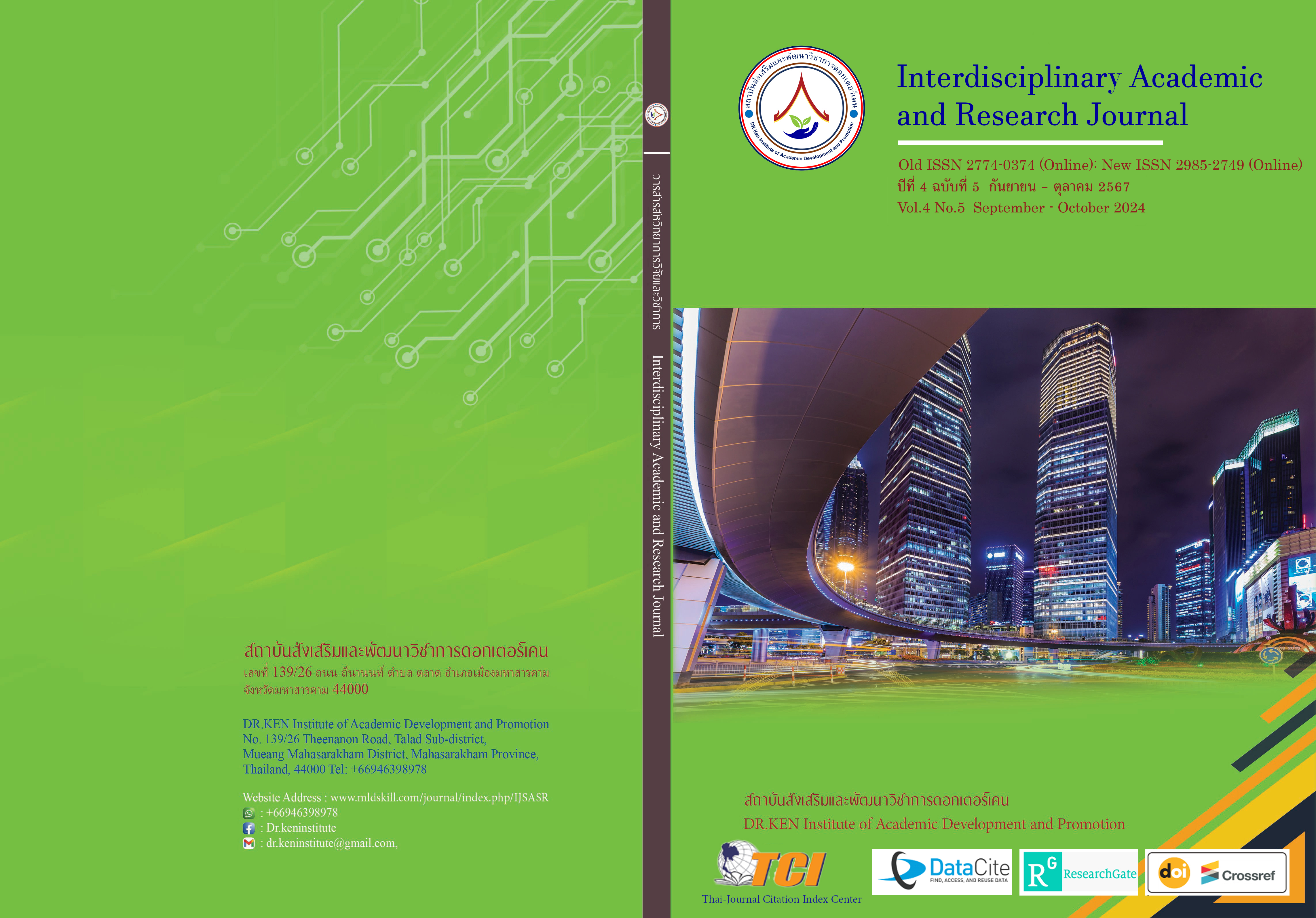Administration of Vocational Education Bilateral System of Educational Institutions under the Office of the Commission Rayong Province Vocational Education
DOI:
https://doi.org/10.60027/iarj.2024.276969Keywords:
Vocational Education Administration; , Bilateral System; , Vocational InstitutionsAbstract
Background and Aims: The study of bilateral vocational education administration in educational institutions under the Rayong Vocational Education Institute aims to: (1) assess the level of vocational education administration within the bilateral system of vocational institutes in Rayong Province, based on the standards set by the Vocational Education Commission; (2) compare the levels of vocational education administration between different vocational education institutes in Rayong Province; and (3) explore guidelines for promoting or developing the administration of vocational education under the bilateral system within institutions under the Rayong Vocational Education Institute.
Methodology: The study involved 201 participants in the sample group. Data collection was carried out using questionnaires with a 5-point rating scale and structured interviews, yielding Item-Objective Congruence (IOC) values between 0.80 and 1.00, and a reliability coefficient of 0.97. Statistical analysis included t-tests, F-tests, as well as frequency, percentage, mean, and standard deviation to effectively interpret the data.
Results: (1) The Rayong Vocational Education Institute oversees a bilateral system of educational institutions, and the vocational education administration demonstrates a high level of proficiency in four main areas: curriculum, measurement and evaluation, collaboration between establishments and educational institutions, and graduate quality. (2) Using a t-test, vocational education administration in the bilateral system was analyzed based on categories such as position, educational level, individual items, and overall assessment. An F-test was also conducted to assess differences according to the size of the educational institutions. While administrators and teachers from different positions, educational backgrounds, and institution sizes had varied opinions on vocational education administration, there were no significant overall differences in perception. (3) Comprehensive guidelines for enhancing the administration of vocational education in the bilateral system should focus on four key areas: 1) improving graduate quality, 2) enhancing the curriculum, 3) fostering collaboration between businesses and educational institutions, and 4) refining measurement and evaluation processes.
References
กฤติกา ไหวพริบ และคณะ. (2561). การบริหารการศึกษาระบบทวิภาคีโรงเรียนป้อมนาคราชสวาทยานนท์ จังหวัดสมุทรปราการ. วารสารครุศาสตร์ปริทรรศน์, 5(3), 97-106.
จอมพงศ์ มงคลวานิช. (2561). การบริหารอาชีวศึกษาระบบทวิภาคี. กรุงเทพมหานคร: สำนักพิมพ์จุฬาลงกรณ์มหาวิทยาลัย.
ธนภัทร แสงจันทร์ และคณะ. (2564). รูปแบบการบริหารอาชีวศึกษาระบบทวิภาคีที่มีประสิทธิผลของสถานศึกษา สังกัดสำนักงานคณะกรรมการการอาชีวศึกษา. สิกขา วารสารศึกษาศาสตร์, 8(2), 76-85.
นวลอนงค์ ธรรมเจริญ. (2558). การพัฒนารูปแบบการบริหารจัดการอาชีวศึกษาระบบทวิภาคีโรงเรียนในโรงงานแบบบูรณาการ. วิทยานิพนธ์ ปร.ด., มหาวิทยาลัยเทคโนโลยีพระจอมเกล้าพระนครเหนือ, กรุงเทพฯ.
บัณฑิต ออกแมน. (2560). การพัฒนารูปแบบความร่วมมือการจัดการอาชีวศึกษาระบบทวิภาคีระหว่างสถานศึกษาสังกัดสำนักงานคณะกรรมการการอาชีวศึกษากับนิคมอุตสาหกรรมอมตะนคร. วิทยานิพนธ์. ปร.ด., มหาวิทยาลัยเทคโนโลยีพระจอมเกล้าพระนครเหนือ, กรุงเทพฯ.
บุญชม ศรีสะอาด. (2556). การวิจัยเบื้องต้น. พิมพ์ครั้งที่ 9. กรุงเทพฯ : สุวรียาสาส์น.
ประกาศกระทรวงศึกษาธิการ. (2557). มาตราฐานการจัดการอาชีวศึกษาระบบทวิภาคี. ราชกิจจานุเบกษา131. (ตอนพิเศษ 239ง). 1-5.
พระราชบัญญัติการอาชีวศึกษา. (2551). ราชกิจจานุเบกษา125. (ตอนที่ 43ก). 1-24.
ภูวเรศ อับดุลสตา และวรรณดี สุทธินรากร. (2561). การพัฒนาระบบทวิภาคีของการอาชีวศึกษา. พิมพ์ครั้งที่ 1.กรุงเทพฯ : สยามปริทัศน์.
สำนักงานคณะกรรมการการศึกษาแห่งชาติ. (2545). พระราชบัญญัติการศึกษาแห่งชาติ พ.ศ. 2542 แก้ไขเพิ่มเติม (ฉบับที่ 2) พ.ศ. 2545. กรุงเทพมหานคร.
สำนักงานคณะกรรมการการอาชีวศึกษา. (2556). การจัดการอาชีวศึกษาระบบทวิภาคี. กรุงเทพมหานคร: ศูนย์อาชีวศึกษาทวิภาคี.
สุทธิรักษ์ ทัศบุตร. (2564). การบริหารการศึกษาอาชีวศึกษาระบบทวิภาคี ของสถานศึกษาในสังกัด สำนักงานคณะกรรมการการอาชีวศึกษา. วารสารบริหารการศึกษาบัวบัณฑิต, 21(1), 59-66.
สุทธิรักษ์ ทัศบุตร. (2566). การบริหารจัดการอาชีวศึกษาระบบทวิภาคีของสถานศึกษา ในสถาบันการอาชีวศึกษาภาคตะวันออกเฉียงเหนือ 4. วารสารวิชาการมหาวิทยาลัยราชภัฏศรีสะเกษ, 17(1), 103-117.
สุวารี แปงณีวงค์ และสมเกียรติ ตุ่นแก้ว. (2567). การพัฒนารูปแบบการบริหารการจัดการอาชีวศึกษาระบบทวิภาคีที่รองรับการเปลี่ยนแปลงในศตวรรษที่ 21 ของสถานศึกษาอาชีวศึกษากลุ่มภาคเหนือ. วารสารวิจยวิชาการ, 7(1), 217-232.
Krejcie, R. V., & Morgan, D. W. (1970). Determining sample size for research activities. Educational and Psychological Measurement, 30(3), 607–610.
Downloads
Published
How to Cite
Issue
Section
License
Copyright (c) 2024 Interdisciplinary Academic and Research Journal

This work is licensed under a Creative Commons Attribution-NonCommercial-NoDerivatives 4.0 International License.
Copyright on any article in the Interdisciplinary Academic and Research Journal is retained by the author(s) under the under the Creative Commons Attribution-NonCommercial-NoDerivatives 4.0 International License. Permission to use text, content, images, etc. of publication. Any user to read, download, copy, distribute, print, search, or link to the full texts of articles, crawl them for indexing, pass them as data to software, or use them for any other lawful purpose. But do not use it for commercial use or with the intent to benefit any business.
















.png)


